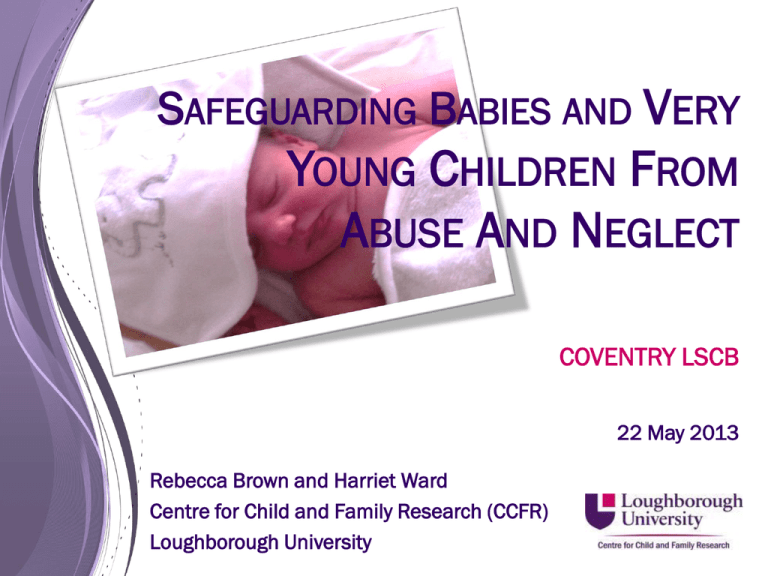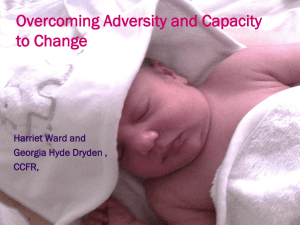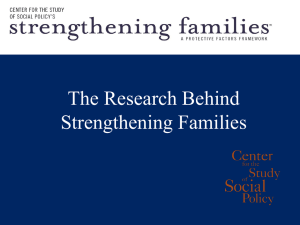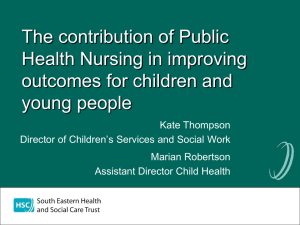Safeguarding Babies and Very Young Children
advertisement

SAFEGUARDING BABIES AND VERY YOUNG CHILDREN FROM ABUSE AND NEGLECT COVENTRY LSCB 22 May 2013 Rebecca Brown and Harriet Ward Centre for Child and Family Research (CCFR) Loughborough University Why babies? Infants under the age of one are: • Nearly three times as likely as others to be subjects of child protection plans due to physical abuse • More than twice as likely to be subjects of child protection plans due to neglect • Subjects of 45% of serious case reviews (into child death or serious injury) • Eight times the average risk of child homicide Safeguarding Children Across Services (Davies, C. and Ward, H. 2012) • 15 studies initiated following the death of Victoria Climbié in 2000; informed by death of Peter Connelly in 2007 • Key themes: – Identification and initial response to abuse and neglect – Effective interventions – Inter-agency and inter-disciplinary working – Focus on neglect and emotional abuse Safeguarding Babies and Very Young Children from Abuse and Neglect: (Ward, Brown and Westlake 2012; Ward, Brown and Maskell Graham, 2012) • Prospective longitudinal study of 57 babies identified as suffering or likely to suffer significant harm • All identified before first birthdays; almost two thirds (65%) before birth • 43 followed until age three; 37 until age five so far • Data from case papers; annual interviews with birth parents/carers; Strengths and Difficulties Questionnaires Parents’ difficulties • Primary risk factors: violence (at home and in community), substance misuse issues, mental ill health, learning disabilities, experiences of abuse in childhood • Secondary risk factors: housing problems including homelessness, financial problems including bankruptcy • Isolation, poor relationships with extended family • Twenty mothers and an unknown number of fathers had already been permanently separated from at least one older child Children • Majority from families already known to children’s social care through involvement with older siblings • 65% identified before birth; almost all before they were six months old • 63% were boys • 69% White British; 31% from BME groups: 69% of these were of mixed heritage. High proportion of BME infants found in other studies (see Selwyn et al. 2010) • 14% were identified as having disabilities or special health care needs. Children with disabilities are 3.4 times more likely to experience abuse and neglect (Sullivan and Knutson, 2000) Classifying Families by Risk of Harm • Based on systematic review of evidence concerning risk and protective factors and the likelihood of maltreatment or its recurrence (Hindley, Ramchandani and Jones, 2006) • Each child classified according to the level of risk of maltreatment or its recurrence • Classification used date at identification by children’s social care (Time One) at age three (Time Two) and at age five (Time Three) • Particular weight given to evidence of parents’ capacity for change The Children at Entry • Severe risk (12:28%): Risk factors, no protective factors and no capacity for change • High risk (7:16%): Risk factors, protective factors and no capacity for change • Medium risk (21:49%): Risk factors, protective factors, capacity for change • Low risk (3:7%): No risk factors (or previous risk factors addressed, protective factors and capacity for change. Includes two outliers At age three • 37% (16) low risk: adequately safeguarded, living with birth parents who had sustained positive changes • 35% (15) low risk: permanently separated • 28% (12) medium-severe risk: inadequately safeguarded with birth parents who had not shown capacity to change • 53% (23) had experienced abuse or neglect • 37% (16) maltreated in utero • 37% (16) maltreated while open cases • 57% displayed emotional problems or substantial behavioural difficulties • No evidence that 20 (47%) children experienced maltreatment by the time they were three At age five • Over a third (38%) at continuing risk of harm • Children who were safeguarded from domestic violence at three no longer safe at five • Almost half the separated children in fragile placements • Widespread developmental delay: poor speech and language • One in three displaying emotional and behavioural patterns sufficient to warrant referral for clinical support – three times expected prevalence • Behavioural issues: extreme aggression; self harming • Problems more prevalent amongst late separated children and those living with birth parents but inadequately safeguarded Acceptable and unacceptable parenting in a civilised society • Nobody died • BUT the sample includes children who: – – – – – Were not fed for so long that they ceased to cry Could explain how to prepare heroin for consumption Were allowed to taste illicit drugs from a spoon Were left to forage for food in the waste bin Were locked in their bedrooms for hours on end with nothing to do – Routinely arrived at school unfed and in filthy clothes • Children’s development and long-term wellbeing compromised Messages for Practice • Understanding the impact of abuse and neglect • Implications of not acting on concerns • Early identification and swift referral • Identifying effective interventions and parents who can change • Keeping the focus on the child Early identification and swift referral: Messages that need wider dissemination • Close relationships between child maltreatment and parents’ substance misuse, mental ill health, and domestic violence, particularly in combination (Cleaver, Unell and Aldgate, 2011) • Failure to meet basic needs; emotional unavailability; inability to protect; inability to focus on the child • Severe learning disability associated with neglect and emotional abuse, particularly when domestic violence, substance misuse and/or mental health problems are also present Early identification and swift referral • 22/53 referred by health professionals • Only one child referred by drug and alcohol services • Tensions between adult and children’s services • Reluctance to consider impact of adults’ problems on parenting behaviour and child’s development • Reluctance to refer: fears of inappropriate or precipitate response • Concerns about sharing information Reasons for swift decisive action • Brain develops particularly rapidly in the first two years but majority of neurons formed pre-birth • Foundations for empathy, trust and impulse control laid within the first two years • Quality and sensitivity of mother-child interaction at 6-15 weeks correlates with attachment relationship at eighteen months • Witnessing domestic abuse harms babies as young as nine months; pregnancy can be a trigger for domestic abuse • Gross neglect in the first three years impairs social and cognitive development Timeframes for decision making (Separation) • Separation at birth was extremely rare On average it took: – 7.5 months for a definitive decision to place away from home – 7 more months for this to be fully actioned – Five months minimum to find suitable adoptive home • No new permanence decisions between ages three and five • Separations at six and seven following pressure from schools If adoption is the best solution • Where children cannot be safeguarded by birth family: – Babies placed for adoption before first birthdays are more likely to become securely attached to adoptive carers than those place later – High proportion (c60%) of permanently separated infants experience double jeopardy: delayed separation followed by delayed permanence Children placed for adoption: national timescales • Average age at permanent separation – 14 months • Average age at permanent placement – 36 months • Children aged six months at entry likely to be placed at 25 months; those aged 6 ½ years at entry likely to be placed at 9 ¼ years • 90 (2%) children p.a. adopted aged 10+ Average time between entry to care and placement with adoptive family: 22 months Pathway One: (double jeopardy) • Child has experienced abuse in birth family followed by stable placement in care • Develops secure attachment to temporary carers • Disrupted attachment when placed with adoptive carers Average time between entry to care and placement with adoptive family: 22 months Pathway Two: (repeated disruptions) • Child enters care precipitately and is placed in temporary placement • First temporary placement can lead to a sequence, including repeated, failed returns • Repeated changes of caregiver replicate previous experience and reinforce insecure attachment patterns • Increased difficulties in developing secure attachment to adoptive carers (see Ward, Munro and Dearden, 2006) Identifying parents who can change • Just over a third of parents (16:37%) successfully overcame adversities to meet the needs of their children within appropriate timescales • They received some effective interventions, but these were often short term, and ended abruptly • No evidence of intensive evidence based interventions designed to address their needs (eg PUP; MST CAN) Which parents can change? (Tentative data) Parents who successfully changed were: • Less likely to have experienced abuse in childhood and substantially less likely to have experienced childhood sexual abuse • Able to come to terms with the removal of older children • Able to acknowledge the risks posed by their destructive behaviour patterns • Able not simply to engage with services but also to make positive use of the support they offered • Able to develop supportive informal networks The birth of a child as a catalyst for change • No parent overcame substance misuse if they continued to use drugs after the child had been born • All but one set of parents who made and sustained sufficient changes, had addressed all known risk factors by the time the child was six months old • A number of parents, including four of those who overcame substance misuse, spoke of a ‘wake-up call’ that acted as a catalyst for change. No parents in the insufficient change group spoke of such an epiphany Simon’s mother: what made her change? “My son being born, my son being born, definitely. And I think the scare what social services gave me was a kick up the arse and the scare that I needed…They were going to put [Simon] into foster care…And I thought to myself, I just cannot, you know, you know what, it felt like a movie, I felt like, oh my god, my baby, not my baby. And he was so tiny, I felt like, oh no my baby, I felt like, and I thought you’re having a laugh, I couldn’t believe, you know…A big shock, a big shock, it was a big wake-up call and it was just a terrible feeling, I couldn’t believe it.” Practice Implications • Risk and protective factor methodology helpful in identifying who may change – and who may not • Pre-birth risk assessment would be valuable – especially if it led to action • Some parents do not have capacity to change in time for this particular child • Change needs effective specialist help and long term ongoing support • Some solutions, especially for domestic violence, are not helpful Keeping a focus on the child • Almost all professionals gave parents every opportunity to demonstrate capacity to change • The social workers’ role is to safeguard the children, not to preserve the family at all costs • Children’s rights can be in conflict with parents’ rights • The hardest task is to keep the focus on the child • Even harder when babies grow older and new siblings take their place Possible ways forward: Speeding up adoption process • Faster decision-making • More children placed for adoption • New targets and benchmarking BUT • May lead to more children waiting in limbo – shortage of adoptive families • May lead to more children being unnecessarily separated • Only ever suitable for very small number of children • One element in a wider strategy Possible ways forward: more effective and more timely services • Better, more timely assessment (pre-birth assessment is rare) • More use of evidence based programmes (e.g. Parents Under Pressure; Family Nurse Partnerships; MST-CAN) • Better development and integration of school based interventions • Better development of processes for stepping down (and stepping up) Possible ways forward: addressing the underlying factors • Primary risk factors for maltreatment include: substance misuse, domestic and community violence; mental health problems; experience of abuse in childhood, especially in combination • Secondary stressors include: poverty, unemployment, poor housing; social exclusion; inequality • Addressing the factors that underlie maltreatment is a necessary step towards reducing the prevalence References Davies, C. and Ward, H. (2012) Safeguarding Children Across Services: Messages from research. London: Jessica Kingsley Publishers Hindley, N., Ramchandani, P.G. and Jones, D.P.H. (2006) ‘Risk factors for recurrence of maltreatment: A systematic review.’ Archives of Disease in Childhood 91, 9, 744-752. Jones, D., Hindley, N. and Ramchandani, P. (2006) ‘Making plans: assessment, intervention and evaluating outcomes’ in Aldgate, J., Jones, D. And Jeffery, C. (eds) The Developing World of the Child, London: Jessica Kingsley Publishers. Lewis, M., Feiring, C., McCuffog, C., and Jaskir, J. (1984) ‘Predicting psychopathology in six year olds from early social relations’, Child Development 55, 123-136 Sullivan, P. and Knutson, J. (2000) ‘Maltreatment and disabilities: A population based epidemiological study.’ Child Abuse & Neglect 24, 10, 1257-1273. Van den Dries, L., Juffer, F., Van IJzendoorn, M.H. and Bakermans-Kranenburg, M.J. (2009) ‘Fostering security? A meta-analysis of attachment in adopted children.’ Children and Youth Services Review 31, 410-421. Ward, H., Brown, R. and Westlake, D. (2012) Safeguarding Babies and Very Young Children from Abuse and Neglect. London: Jessica Kingsley Publishers. Ward, H., Brown, R. and Maskell-Graham, D. (2012) Young Children Suffering, or Likely to Suffer, Significant Harm: Experiences on Entering Education. DFE RR209, London: Department for Education. Safeguarding Children Research Initiative www.education.gov.uk/researchandstatistics/research/scri Free download of briefing papers, research briefs and the overview book Ward, H. Brown, R. and Westlake, D. Safeguarding Babies and Very Young Children from Abuse and Neglect, London: Jessica Kingsley Publishers Thank you H.Ward@lboro.ac.uk R.C.Brown@lboro.ac.uk Website: www.lboro.ac.uk/research/ccfr/








